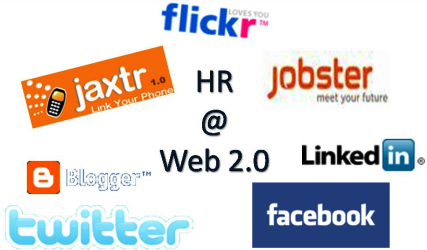Linkedin recently launched its new version which has more upgraded features and better integration options and even access via mobile phones and PDA’s. Increasingly I see more and more recruiters using web based networking tools for hiring middle and senior level managers. Members are also directly approaching employees from different organizations to explore options in the organization of their own choice. This is an interesting tread as more and more people are using the networking tools to directly get in touch with the prospective employers. LinkedIn is supposed to have more than 20 million registered users and with the new users joining every day it has a user base which allows plethora of options. Unlike facebook which started as a tool for connecting to campus buddies, LinkedIn is seen as a professional and no-nonsense application.
Web 2.0 and hiring philosophies have been widely used by small and starts up as it gives them the depth and breadth to choose the selected few as they have some niche roles to offer. It’s interesting to note that Facebook hired many of its early employees through LinkedIn. E&Y has a page on Facebook, through which it interacts with prospective employees
Consider this survey, entitled Recruitment Advertising: Moving in New Directions, from companies ranging from $5 million to $5 billion in annual revenues (and from a variety of industry segments) -- said they would spend more on business-networking sites, social networking and employee-referral programs in 2008 than in 2007, but less on print and traditional job boards.
On the other hand some argue that your social profiles on these sites may even backfire in case your prospective employer, client or even business partner decides to search your web footprints using goggle or social networking sites. This interesting conversation on Business week has some interesting observations.
A public profile is a vehicle for casually interacting with others in an informal setting, on personal free time. When companies use these profiles to find not only a professional but also an ideological match for a job, they’re misleading themselves and building ill will with talented prospective employees, who might decline to apply for a job for fear a comment about China on their blogs makes them persona non grata.
A recent survey of 700 HR executives found that 64 percent said their companies block access to social-networking sites such as Facebook and MySpace, while 63 percent block access to blogs and nearly 70 percent prevent their employees from accessing video or photo-sharing sites such as YouTube and Flickr. The study, conducted by Redwood City, Calif.-based security firm Clearswift, also found 54 percent of the HR professionals have had to discipline employees for "wasting time" on the Internet.
I was just wondering how a twitter, facebook or linkedin will help organizations in creating a passionate community of niche users within the organizations. Bulletin boards and blogs have been tried but engaging them through intranet portal will be something really interesting. Given the size and spread of huge big organizations it may be a good tool for creating a more diverse and better connected workforce.
This HRE article has some interesting examples on the latest web 2.0 tools used by organizations.
Some companies that have implemented Web 2.0-type tools in the workplace have found they're a useful way to spark creativity among employees and increase engagement and interaction among -- and between -- employees and customers. Palo Alto, Calif.-based Hewlett-Packard recently launched HP Uncut, a YouTube-like
system that lets HP employees make their own videos that demonstrate best practices for using and maintaining HP products and then upload them to the corporate Web site.
Taleo has built its Taleo Business Edition application on Facebook Platform, which enables companies to integrate their recruiting applications with Facebook, giving them access to millions of users (and potential job candidates).
Penny Davis, head of HR operations at mobile phone operator T-Mobile says “ it's time for HR professionals to take a fresh look at Web 2.0, and how it can help them tap into new talent pools, encourage staff to collaborate, and build their employee brand”.
In the past year, for example, Davis and her team have used Facebook to help new graduate recruits make the transition to the world of work. "We set up a group on Facebook in May for the 2007 intake so that they could network informally with each other and the T-Mobile recruitment team before their September start date, enabling them to get to know each other and air concerns in a friendly, supportive environment. ."
Management consultancy KPMG, for example, the Royal Bank of Scotland, or data storage giant EMC. All three held careers fairs in Second Life during 2007.

No comments:
Post a Comment